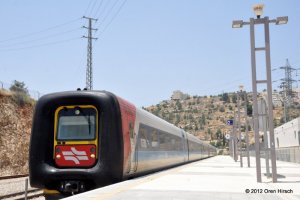About one month ago, after many delays and some fanfare, Israel Railways inaugurated service on the new Tel Aviv-Jerusalem High Speed Rail line, the first time that Israel’s capital city is connected to the rest of the country by a train line that is actually competitive with driving. However, for reasons that can only be explained as politicking, the line is open despite not being ready for full operations just yet. Trains are operating every half hour on weekdays between Jerusalem and Ben Gurion Airport, at which point passengers must transfer to another train in order to continue the rest of the way to Tel Aviv. The power substations along the line are temporary, and several trains have gotten stuck along the line with passengers on board when the temporary electrical system is extended beyond its capabilities. The line does not operate evenings and weekends so crews can finish the line and bring it to full operational status, which will take longer than it would if the crews could work 24/6 instead of needing to clear the tracks for revenue service each weekday. Eventually, the trip between Jerusalem and Tel Aviv will take 35 minutes and not require a change of trains.
One question I’ve often received over the past few years while this new line is being constructed is what does the future hold for the old Tel Aviv-Jerusalem train line? This line was constructed by the Ottomans and opened in 1892, and despite the fact it takes well over 90 minutes to travel between Jerusalem and Tel Aviv and carries few passengers, it has been in operation ever since the line was reopened following extensive repairs and the construction of a new terminal at Malha in Jerusalem in 2005. While this train route may not be the fastest way to get between these cities, it is quite pretty, as the train winds its way through the hills. However, the beautiful scenery along the route will not be enough to save the line; the segment between Beit Shemesh and Jerusalem is likely to be closed at some point in the future after the new high speed line is fully operational.
Last week in the New York Times, Matti Friedman wrote about why he prefers the old Ottoman era train route over the new high speed route. You can read his piece here. And if you find yourself in Israel with enough time to take the scenic train route on your way to or from Jerusalem, do so. You won’t have the chance for too much longer…
